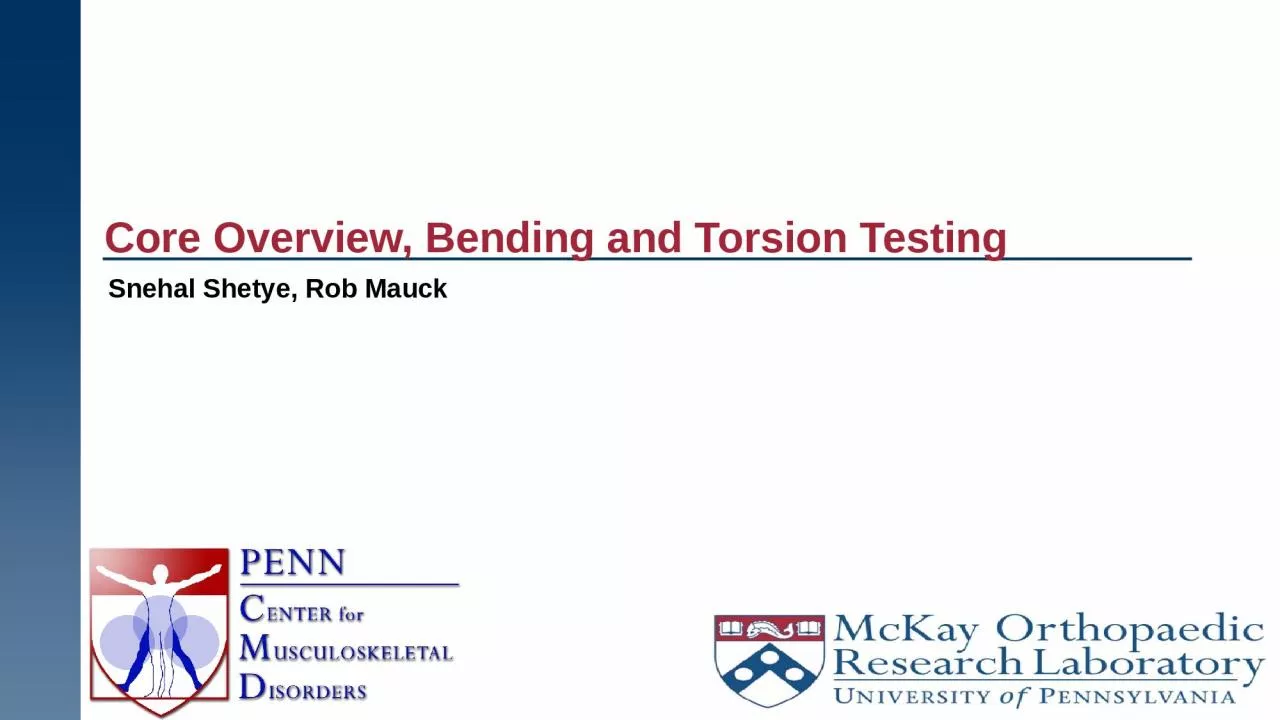

Snehal Shetye Rob Mauck Key players Rob Mauck Director Snehal Shetye Technical Director Ashley Rodriguez Research Specialist httpswwwmedupennedupcmdbiomechanicshtml Submit project request form ID: 1009076
Download Presentation The PPT/PDF document "Core Overview, Bending and Torsion Testi..." is the property of its rightful owner. Permission is granted to download and print the materials on this web site for personal, non-commercial use only, and to display it on your personal computer provided you do not modify the materials and that you retain all copyright notices contained in the materials. By downloading content from our website, you accept the terms of this agreement.
1. Core Overview, Bending and Torsion TestingSnehal Shetye, Rob Mauck
2. Key players:Rob Mauck (Director)Snehal Shetye (Technical Director)Ashley Rodriguez (Research Specialist)https://www.med.upenn.edu/pcmd/biomechanics.htmlSubmit project request formIn reality most PIs just directly contact RobRob and Snehal sit down with client group to review proposed project, feasibility, approach.Core user has a choice:Self-service (you get trained and then test yourself)Fee for service (Snehal and Ashley do the project for you)After getting trained, you get access to Google Calendar for the particular equipmentRemember to cite us in your manuscript:Grant number is P30 AR069619Biomechanics Core – How we operate
3. Instron 5542 (x2)Instron 5543Instron 5848 (x2)Instron ElectroPulsInstron 8874Compression MicroTesterFreezing Stage MicrotomePolarizing ScopeDynamic Cross-Polarized Light Imaging SetupGisMO (cross-sectional area measurement device)3D PrinterSoftwareMATLAB, GraphPad, SPSS, Abaqus, Trellis, Rhino 3D, QCapture ProMilling Machine, Mini-Lathe, Vertical and Horizontal Bandsaws, Soldering and Electrical EquipmentAvailable Equipment
4. Signup on Google Calendar:PCMD:<PI Last Name>:<your pennkey>Note: McKay does get first dibs on equipment usageGenerally, you can only access equipment between the hours of 9-5pmWe can bend the rules for special circumstancesAll hardware is shared among all users, including McKay, so usually allocate extra time for find your fixtures!Format is importantWe summarize quarterly usage and send invoices to PIsCurrent PCMD Biomechanics core discount: 90%If there is a scheduling conflictTalk to Snehal or email the other person (pennkey is on calendar signup) and ask nicelyAccessing SnehalDon’t hesitate to contact me anytime (I am at McKay from 6:30am to 4pm)Do remember I have two jobs: Soslowsky Lab and PCMD Biomechanics CoreSigning up and Etiquette
5. 3-point Bending3-point testLoad (F)
6. Shear and Moment DiagramMaximum moment at center point of beam
7. 4-point Bending4-point testLoad
8. Shear and Moment DiagramMaximum moment spans distance between top actuators
9. Maximum Flexural StressHere, is 2nd moment of inertia, = moment applied at middle of specimen, = distance from center of specimen to convex surface Elastic Modulus (for 3-point bending) (for 4-point bending)Here, is deflection at max. force, is length between bottom supports, and is max. forceBending StiffnessSlope of linear region from force-displacement curve ParametersTensionCompression
10. Laws of static mechanics:Sum of all forces Sum of all moments at a single point These two equations will resolve the unknown reaction forces at the bottom supportsMoment at any point can now be calculated3-point Bending:4-point Bending How do we calculate ?
11. This is difficult for biological specimensFor boneObtain uCT scans of mid-shaftWe have a custom MATLAB code that calculates for any chosen axis (Bending Buddy)This code also estimates by fitting circle to bone cross-section and obtaining equivalent radius How do we calculate ?
12. Measure length of all your samples to determine proper support spacing3-point bending not recommended for fractured bone4-point bending is generally always recommended over 3-point unless tissue is too smallTorsion tests work well for fractured specimensMost ideal to test all samples on same day (day-to-day variation in test setup can influence results)Keep orientation constant for all samples!Find a stable orientation such that bone does not rotate while being loadedStuff to Consider
13. Example4-point bend setup
14. Failure modes in bone
15. 3-pt or 4-pt bend tests work well for intact specimens Fractured samples3-pt test will cause significant stress concentrations at the contact pointUsually that is where the fracture/callus isDefinitely not recommended4-pt test loading points should span the healing siteDifficult to achieve on mouse femora/tibiaeCannot control size and location of fracture callusTorsionUsually have unobstructed access to epiphysisOnly test that evaluates the entire free length of the boneDoes need 6-dof fixation at the terminiTakes longer for prep and setupWhen to use torsion tests?Load (F)Load
16. Torsion testing
17. Polar Moment of Inertia - perpendicular axis theoremObtain and from Bending BuddyRequires uCT scan for each sampleDon’t use default output from uCT Torsion Parameters
18. Shear modulus Parameters we can reportMax. torqueAngular rotation at max. torqueTorsional stiffnessShear Modulus ()Torsional Rigidity ()Where is max. torque applied, is length of specimen being tested, and is twist (in radians) at max. torque Things to rememberExpect a spiral fractureMake sure to take a gauge length image to obtain And a scale image!If testing fractured samples, each sample needs to be mostly straight and vertical Polar moment of inertia
19. Torsion Testing
20. Questions?